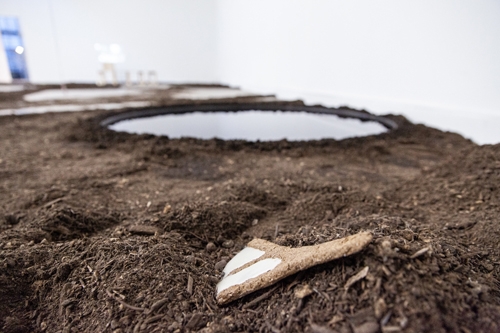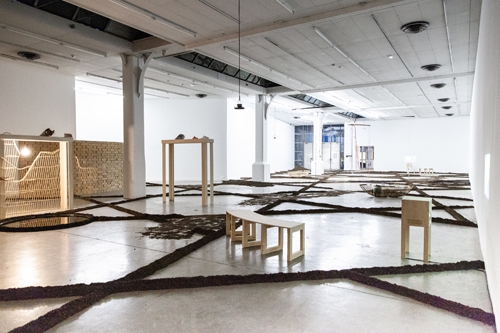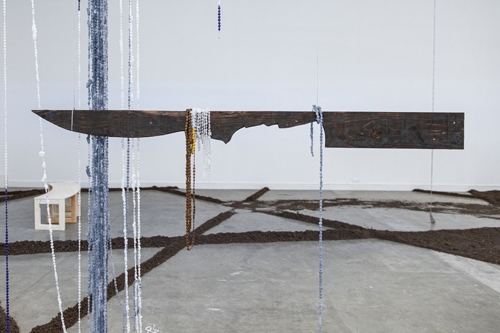The title of the exhibition I Killed the Butterfly in My Ear echoes the last phrase of an earlier film by Minia Biabiany, Toli Toli (2018): “Butterflies cause blindness when they blow in your ears.” Escaping from this state of cecity as the only alternative for understanding history, by questioning the mechanisms of interiorisation of a common, colonial, slave-trading past: this is what Minia Biabiany does, a Caribbean artist born in Basse-Terre. She raises these questions at the MAGASIN des horizons in an experiment with the body in space, in which the exhibition becomes the field of physical explorations placing us within a reality interconnected with the Guadeloupean territory and the site of production of the artworks. The use of artisanal Caribbean practices meets local expertise here, particularly basketwork, with the participation of Coralie Beltrame and the Vannerie de Villaines. These traditions are based on transmission and the repetition of gestures, within an intrinsically meditative practice.
And it makes revolution possible.
Ki valé tousa ki owa mwen.1
The exhibition poses a relationship to history and its grey areas, designed as an awareness-raising space, where physicality plays an emancipatory role for visitors. They traverse and encompass a system of clay geometric shapes, materialising the framework of the weaving of traps and fish nets notably used in the Caribbean. The canvas on the floor redefines the circulation within the space in order to better compare sculpture’s elements: films, braids in white wicker, wax, and circles of water. The non-linearity of our movements questions our impact on the ground and the earth, where each step takes on a loaded political dimension. Minia Biabiany identifies in particular the abusive use of kepone, an insecticide used in the French West Indies for over twenty years, up until 1992, in an attempt to fight the banana tree weevil, at the cost of local ecosystems and the health of the residents. The contamination of the soils caused the multiplication of cancerous diseases, prenatal cases, and sterility, while largely favouring the metropolitan food production and its market.
Open eyes believe they see.1
The sound introduced by the conch – a shell transformed into a natural means of communication, audible many kilometres away – has various significations within the exhibition: the presence of fire, death, and rebellion. The ‘concha’ is also a zone located inside the auricle of our ear, a resonating chamber that brings sound waves to our eardrum, in order to amplify certain frequencies. From the mineral element to the body, what is to be done today, if not to remember, harmonise and reconnect with nature, undertaking tiny acts to counter the destruction caused by humans and our over-use of chemicals, on our own land, resulting in importations of cultures into soils that, in the end, are especially unfavourable to their development.
Bodies reclaim the echo, until the shame is healed.1
Devised as the extension of an artwork created at the CRAC Alsace in 2019, Qui vivra verra, Qui mourra saura [Who Lives Will See, Who Dies Will Know], the installation at MAGASIN des horizons expresses a garden space in which the body of the visitors is projected into an experience of time and space undergoing transformation. Qui vivra verra, Qui mourra saura was based on an anthropological book on the Guadeloupean garden,2 enabling the association between the symbolism of the plants and their position in the garden according to the different transitions in life, in a space circumscribed using lines of salt. The tracing on the ground, as with the exhibition I Killed the Butterfly in My Ear, encourages us to focus our attention on our footsteps, slowing down our spatial experience, marking moments of pause in order to better see and hear the world around us. The butterfly’s breath must stop so that revolution becomes possible.
Notes
- The texts in italics come from the video Pawòl sé van (in Creole, “words are the wind”) present within the exhibition I Killed the Butterfly in My Ear.
- Catherine Benoît, Corps, jardins, mémoires. Anthropologie du corps et de l’espace à la Guadeloupe (Paris: CNRS Éditions / Éditions de la Maison des sciences de l’homme, 2000).









